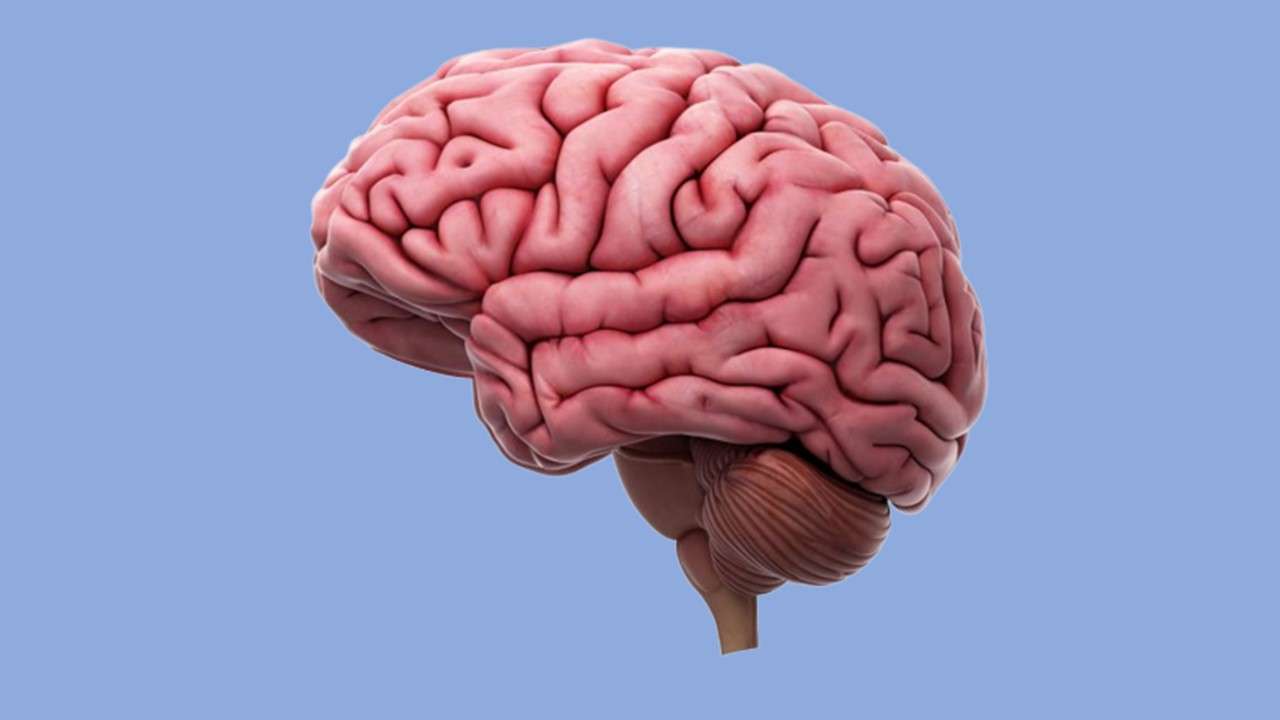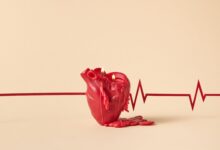The brain (from the Latin cerebellum, diminutive of cerebrum) is the most complex organ in the human body. Seat of our thoughts, our emotions and master of our movements (except reflexes), it is the key element of the nervous system.
brain anatomy
The cerebrum belongs to the encephalon, which also includes the diencephalon, the brainstem and the cerebellum.
The brain is housed in the cranium which protects it from shocks. It is also surrounded by three protective membranes, the meninges (dura mater, arachnoid mater, and pia mater). In adults, it weighs about 1.3 kg and contains several billion nerve cells: neurons. It is suspended in the cerebrospinal fluid, a shock-absorbing liquid that allows the transport of molecules and the recovery of waste.
External structure
The brain is divided into two parts: the right hemisphere and the left hemisphere. Each hemisphere controls an opposite part of the body: the left hemisphere controls the right side of the body and vice versa.
The left hemisphere is generally associated with logic and language, while the right is the seat of intuitions, emotions and artistic sense. They communicate through a structure of nerve fibers: the corpus callosum. The surface of the hemispheres is covered with cerebral cortex, it is the gray matter because it contains the cell bodies of neurons. The cortex is covered with convolutions, which are folds of brain tissue.
Each hemisphere is divided into five lobes:
- the frontal lobe, in front, just behind the forehead
- the parietal lobe, behind the frontal
- the temporal lobe is on the side, near the temporal bone
- the occipital lobe, behind, at the level of the occipital bone
- a 5th lobe is not visible on the surface, it is the insula or insular lobe: it is inside the brain.
The lobes are delimited between them by furrows, which are grooves on the surface of the cortex.
Cranial nerves originate in the cerebrum and brainstem. There are twelve pairs that are involved in vision, taste, smell or hearing or in the expressiveness of the face.
The brain is irrigated by the left internal carotid artery and the vertebral artery, which provide nutrients and oxygen necessary for the proper functioning of cells.
Internal structure
The inside of the brain is made up of brain tissue called white matter. It is made up of nerve fibers that carry nerve impulses to or from the cortex. These fibers are surrounded by myelin, a whitish protective sheath (hence white substance) which accelerates the electrical transmission of nerve messages.
In the center of the brain are also cavities called ventricles that allow the circulation of cerebrospinal fluid.
brain physiology
The brain is:
- 2% of our weight
- 20% of the energy consumed
The brain communicates with the whole organism. This communication is carried out in large part by the nerves. Nerves allow the very rapid transmission of electrical messages that are nerve impulses. The brain, control tower of the body
Together with the spinal cord, the brain constitutes the central nervous system. This system is our command and control centre: it interprets sensory information from the environment (inside and outside the body) and can send responses in the form of motor commands (activation of muscles or glands).
Functions such as speech, the interpretation of sensations or voluntary movements originate in the cerebral cortex. The neurons of the cortex interpret the sensory messages and elaborate the appropriate responses at the level of regions specialized in the processing of information. These regions are found at:
- From the parietal lobe, with the areas involved in sensory perceptions (taste, touch, temperature, pain)
- From the temporal lobe, with the areas of hearing and smell, language comprehension
- From the occipital lobe, with the centers of vision
- From the frontal lobe, with reasoning and task planning, emotions and personality, voluntary movements and language production.
Damage to these areas can lead to dysfunction. For example, a lesion of the area dedicated to the production of language then suppresses the ability to pronounce words. People know what they want to say but they can’t say the words.
Brain diseases
Cerebrovascular accident (CVA) : follows the blockage or rupture of a blood vessel, which causes the death of nerve cells. It includes embolism or cerebral thrombosis.
Alzheimer’s disease : neurodegenerative disease that causes a progressive decline in cognitive faculties and memory.
Epileptic seizure : is characterized by discharges of abnormal nerve impulses in the brain.
Depression : one of the most common psychiatric disorders. Depression is a disease that affects mood, thoughts and behavior, but also the body.
State of brain death (or encephalic death): state of irreversible destruction of the brain which results in a total cessation of cerebral functions and an absence of blood circulation. This condition can follow a head trauma or stroke, for example.
Hydrocephalus : corresponds to an excess of cerebrospinal fluid in the brain when the evacuation of this fluid is not done correctly.
Headache (headache) : very common pain felt in the cranial box.
Charcot’s disease (amyotrophic lateral sclerosis or Lou Gehrig’s disease): neurodegenerative disease. It gradually affects the neurons and leads to muscle weakness and then paralysis.
Parkinson’s disease : neurodegenerative disease that results from the slow and progressive death of neurons in an area of the brain that plays an important role in controlling our movements. This is why sufferers gradually make rigid, jerky and uncontrollable gestures.
Meningitis : Inflammation of the meninges which can be caused by a virus or bacteria. That of bacterial origin is generally much more serious.
Migraine : particular form of headache which manifests itself by attacks longer and more intense than the headache.
Schizophrenia : psychiatric illness that causes so-called psychotic episodes: the affected person most often suffers from delusions and hallucinations.
Multiple sclerosis : autoimmune disease that affects the central nervous system (brain, optic nerves and spinal cord). It leads to lesions that cause disturbances in the transmission of nerve messages which affects the control of movements, sensory perception, memory, speech, etc.
Cranial trauma : refers to a shock received in the head at the level of the skull, regardless of its violence. They are very common and have different stages (weak, moderate, severe). Severe trauma causes brain damage and is the leading cause of death among 15-25 year olds. Road accidents are the main cause of injuries, but also accidents related to sports or aggression.
Brain tumor (brain cancer): multiplication in the brain of abnormal cells. The tumor can be benign or malignant .
Prevention and treatments of the brain
Prevention
In 2012, the World Health Organization (WHO) estimated at 17.5 million the number of deaths due to a cardiovascular disease such as stroke. Having a healthy lifestyle could prevent 80% of these strokes. Indeed, adopting a healthy diet , practicing regular physical activity and avoiding tobacco and excess alcohol would help prevent these diseases.
According to the WHO , Alzheimer’s disease is the most common cause of dementia and is thought to be the cause of 60-70% of cases. Unfortunately, there is no proven prevention technique. Nevertheless, paying attention to your diet, maintaining physical activity and mental training are avenues for prevention . Other diseases, such as brain tumors or multiple sclerosis, cannot be prevented because the causes are unknown. Parkinson’s disease cannot be prevented either, but scientific research indicates certain behaviors that could bring about so-called protective effects.
Preventing a headache is possible, however, when it is too persistent or when the usual medications do not work. This prevention can go through a reduction in stress or a reduction in alcohol consumption, for example.
Treatments
Taking certain medications (including antidepressants, muscle relaxants, sleeping pills, anxiolytics, or even antihistamines for allergies) can cause memory loss . But in these cases, they can be reversible.
According to an American study , the exposure of pregnant women to very toxic atmospheric pollutants (resulting from the combustion of wood or coal for example) would cause disturbances in the development of the embryo. The children would notably present behavioral problems and a decrease in intellectual abilities.
brain exams
Biopsy : examination which consists of taking a sample of the brain tumor in order to know the type of tumor and to choose the most suitable treatment.
Transcranial echo-doppler : examination which makes it possible to observe the circulation of blood in the great vessels of the brain. It allows, among other things, the evaluation of head trauma or the diagnosis of brain death.
Electroencephalogram : test that measures the electrical activity of the brain, it is mainly used to diagnose epilepsy.
Brain MRI : magnetic resonance imaging technique, MRI is an examination to detect brain abnormalities. It is used, among other things, to confirm the diagnosis of stroke or the detection of a tumour.
PET scan : also called positron emission tomoscintigraphy, this functional imaging examination makes it possible to visualize the functioning of organs by injecting a radioactive liquid visible in imaging.
Cerebral and spinal scanner : also called computed tomography or computed tomography, this imaging technique uses X-rays to visualize the structures of the cranium or the spine. It is the main examination for the detection of cancer.
Clinical examination : this is the first step in any diagnosis of brain or nervous system disorders. It is carried out by a general practitioner or a brain specialist. First, he asks the patient about his family history, his symptoms… then he proceeds to a physical examination (checking reflexes, hearing, touch, vision, balance…) .
Lumbar puncture : collection of cerebrospinal fluid using a needle, at the level of the lower back (lumbar vertebrae). In this case, its analysis will be able to determine the presence of cancer cells.
History and symbolism of the brain
First discoveries
The electrical nature of nerve messages was first demonstrated by an Italian physician, Luigi Galvani in 1792, through an experiment on a frog’s leg! Almost two centuries later, in 1939, Huxley and Hodgkin first recorded an action potential (nerve impulse) in a giant squid nerve fiber .
Brain size and intelligence
Scientists have long thought that brain size and intelligence could be linked. According to an international study11, intelligence is not determined by the size of the brain, but rather by its structure and the connections between the white matter and the gray matter. It is also mentioned that men, who generally possess larger brains than women, did not demonstrate higher intellectual functions. Similarly, participants with abnormally large brains scored below average on intelligence tests.
For example, Einstein had a smaller than average brain.

